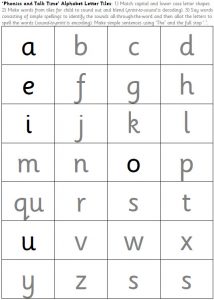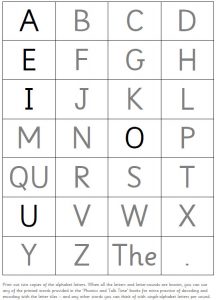FREE Resources
On this page you will find a wide range of extremely useful free resources for foundational literacy (as pdfs and links to Debbie’s further free resources) for: information, training, guidance, assessment, teaching and learning purposes – in mainstream and intervention contexts.
Multi-sensory digital and paper-based blended teaching and learning in school and at home:
Wand Phonics with Phonics International and/or No Nonsense Phonics – Click HERE for PDF
*****************************************************
Printable PDF from Teacher Book 2 for ‘Live Webinar’ training.
*****************************************************
The approach to reading material for schools using the Phonics International programme
(Click HERE for PDF download).
Printable ‘Multi-Skills Activities’ pages and ‘Mini Story’ pages for letter ‘m’ as code for /m/ and letter ‘d’ as code for /d/
These additional pages have been designed to be ‘cumulative’ and ‘decodable’ after s, a, t, i, p, n of No Nonsense Phonics Skills Pupil Book 1. Click HERE to download.
Printable and Projectable Frieze Cards for the optional Pupil Books 2+ and 5+
A range of ‘Frieze Cards’ for NNPS Pupil Books 1 to 9 is provided via the USB stick in the NNPS Starter Kit. By request, we have produced these additional Frieze Cards for lesson introductions for Pupil Books 2+ and 5+.
Click HERE to download 2+ Frieze Cards
Click HERE to download 5+ Frieze Cards
(Pupil Books 2+ and 5+ are available to purchase from HERE)
Printable ‘Frieze Miniatures’ of the alphabetic code featured in each No Nonsense Phonics Pupil Book and in the Phonics International programme
Suggestion: These Frieze Miniatures are ideal for providing for ‘home use’ for every learner as the programme/s progress.
No Nonsense Phonics Skills Pupil Book 1 (Phonics International Unit 1)
No Nonsense Phonics Skills Pupil Book 2 (Phonics International Unit 2a)
No Nonsense Phonics Skills Pupil Book 2+ (Optional – code brought forward)
No Nonsense Phonics Skills Pupil Book 3 (Phonics International Unit 2b)
No Nonsense Phonics Skills Pupil Book 4 (Phonics International Unit 3)
No Nonsense Phonics Skills Pupil Book 5 (Phonics International Unit 4)
No Nonsense Phonics Skills Pupil Book 5+ (Optional – code brought forward)
No Nonsense Phonics Skills Pupil Book 6 (Phonics International Unit 5)
No Nonsense Phonics Skills Pupil Book 7 (Phonics International Unit 6a)
No Nonsense Phonics Skills Pupil Book 8 (Phonics International Unit 6b)
Code and Word Level Assessment Material for the Full Range of the No Nonsense Phonics Skills Series
Suggestions for Use – Click HERE
Code and Word Assessments – Click HERE
**Note: Ignore the content for Pupil Books 2+ and 5+ if not used.
Further assessment material is available at the bottom of this page. This is in addition to cumulative assessment material on the NNPS USB stick (as supplied with the NNPS Starter Kit) and ongoing formative assessment within the Pupil Books.
Entry Point Assessment
This range of Entry Point Assessments for the No Nonsense Phonics Skills Pupil Books may also be useful for checking code knowledge of capital and lower case letters for the series of the colour-coded Phonics Reading Books from Book 23.
These assessment resources include alphabet and alphabetic code summary pages from the No Nonsense Phonics Skills Pupil Books but with slight modifications for assessment purposes to help you to decide on a starting point in the No Nonsense Phonics programme.
The Say the Sounds pages/posters include correspondences which build up cumulatively from Pupil Books 1 to 8. In contrast, the pages with capital letter correspondences include only each book’s content and will help you to check alphabetic code knowledge in the order that letter/s-sound correspondences are introduced within each Pupil Book 1 to 8.
These assessment pages are also provided via the USB Stick in the No Nonsense Phonics Skills Starter Kit (along with other additional, fantastic, printable/projectable resources on the USB Stick).
Phonics Assessment Tracker for groups and whole classes (Excel Spreadsheet)
Further resources for assessment can be found below.
‘Phonics and Talk Time’ Alphabet Letter Tiles
These tiles are useful in the home or in pre-school, nursery and kindergarten settings. Use for early letter recognition, letter matching and phonics activities of reading and spelling simple words. They can be used alongside Debbie’s two Phonics and Talk Time books.
Grapheme Tiles
These tiles include the letter/sound correspondences featured in the Phonics International programme (Units 1 – 6 of 12 Units) and the No Nonsense Phonics programme (NNPS Pupil Books 1 – 8).
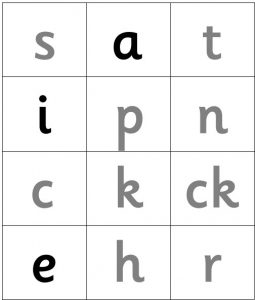
Four Teaching and Learning Tabletop ‘Sounds Mats’
Teach cumulatively, from left to right, the focus graphemes with accompanying key picture-word mnemonics (aid to memory) on one side of the sheets, then assess with jumbled graphemes, row by row, on the reverse sides of the sheets. These can be used with the No Nonsense Phonics Skills programme, and with the Phonics International online programme, or generically to complement other phonics provision ( also available ready-made in our shop).
Sounds Mat 1: Sounds Mat 2: Sounds Mat 3: Sounds Mat 4
Alphabetic Code Charts
The starting point for teaching the most complex alphabetic code in the world for reading and spelling is to make the code ‘tangible’ through the use of Alphabetic Code Charts. These can be designed to be generic or programme-specific and designed for different purposes and users. Debbie has long since maintained that the use of such Alphabetic Code Charts should be the starting point for formally planned phonics provision for informing parents and carers, for training student-teachers, for both teaching and learning purposes in infant and primary schools, for intervention contexts for all ages as required, for teaching English as a new language with any beginners regardless of age, and for clarifying (and being accountable for) the code included in any systematic synthetic phonics programmes.
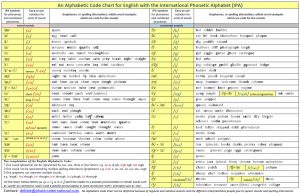
Alphabetic Code Chart for adult use
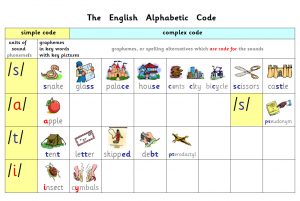
‘Giant’ Alphabetic Code Chart for main display
Debbie promotes the use of Alphabetic Code Charts as high-profile visual aids as ‘giant’ main display charts and as ‘mini’ tabletop charts to support ‘two-pronged systematic and incidental phonics teaching and learning’ for mainstream and intervention as described here:
Debbie lists several ‘Phonics Teaching Tips’ she considers important and helpful to know for systematic and incidental phonics teaching.
Debbie suggests informing learners’ parents/carers about the importance of ‘phonics’, ‘handwriting’, and ‘language comprehension’ for underpinning reading and writing – emphasising the need for masses of ‘talk’ and ‘experience of books’ in the home environment. For this purpose, see this simple explanation of the roles of phonics and language comprehension for reading and spelling here:
How do we teach reading and writing?
For a wide range of printable Alphabetic Code Charts for various purposes, see Debbie’s AlphabeticCodeCharts.com website.
Here is an informative article providing some questions and answers about the adoption of a Year One Phonics Screening Check. The International Foundation for Effective Reading Instruction, of which Debbie is a founding committee member, promotes the global adoption of a year one phonics check. This would achieve a great deal for teachers’ professional development and raise awareness about the need to understand the role of phonics provision and teaching effectiveness:
Phonics for fun, for life-chances and for life!
[Currently, Minister Simon Birmingham is heading up the call for a year one phonics check in Australia, recommended by Dr. Jennifer Buckingham and others, see here.]
Distinguish teaching about the Alphabet compared to the Alphabetic Code

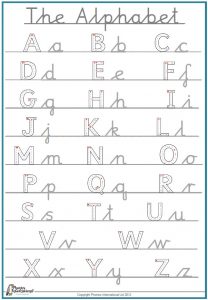
Not only do teachers of reading and spelling need Alphabetic Code Charts to support teaching and learning, they also need Alphabet Posters to teach all about the alphabet letters (upper and lower case) including their phonics links (capital and lower case letters both code for the same sounds), their formation and how they are positioned on writing lines, to teach alphabetical order, and to teach the letter names within the context of teaching about ‘the alphabet’ (learn letter names through singing an alphabet song or chanting). Letter names, however, are not required for the process of learning to read nor the process of learning to spell (oral segmenting for spelling requires identifying the sounds from beginning to end of the spoken word) – although letter names are required simply for relaying a correct spelling from one person to another.
For a range of Alphabet Posters, free guidance (patter) for print and fully joined handwriting and free video guidance for teaching fully joined handwriting, go to
Debbie’s handwriting website.
Please note that Debbie suggests teaching print handwriting very well with NO lead-in joins at first, and then teach a fully joined handwriting style, with lead-in joins, no sooner than six to seven years of age. Teach fully joined handwriting quickly and intensively as suggested via the video footage on Debbie’s handwriting site.
Alphabet Letters in many different fonts
These flash/matching cards are useful to support the teaching of different letter styles. Suggestions for several activities can be found on the final sheet.
Assessment
The following diagrams and documents may be useful for professional development and for foundational literacy assessment. They do not replace standardised reading and spelling tests and formal comprehension tests, but they can complement the use of other literacy assessments.
The Simple View of Reading
The ‘Simple View of Reading’ is extremely important for teachers as it is based on the two main processes required to be a reader in the full sense: 1) the ability to decode and recognise printed words, ‘What ARE the words?’ and 2) the ability to comprehend the spoken language, ‘What do the words MEAN?’. When ascertaining the needs of any learner, this is the starting point for understanding the learner’s needs and for planning lessons whether for mainstream or intervention purposes.
The Simple View of Reading diagram and the equivalent Simple View of Writing diagram can help to ascertain the general reading and writing profiles of your learner or learners. Note the date and age of the learner in the quadrant that most closely indicates the general reading (or writing) profile and then bullet point any theories and knowledge you have of the learners’ difficulties or ‘next step’ needs:
The Simple View of Reading and the Simple View of Writing Diagrams
Debbie Hepplewhite’s Model of the three phonics core skills and their sub-skills
This one-side graphic describes phonics teaching in terms of ‘alphabetic code knowledge’ and ‘three phonics core skills and sub-skills’. Research shows us that handwriting is important not just for competence and presentation reasons but also for aiding both learning to read and to spell. Teachers need to teach handwriting very well. Note the complexity of teaching the sub-skills and core skill of handwriting and the links to teaching about the alphabet and the alphabetic code.
This graphic, then, may be helpful for professional development but also for its focus on assessing individual learners’ phonics skills and sub-skills. Name and date a copy then highlight, tick and annotate to inform your planning. It may also help to evaluate your phonics provision to date and what you might need to adjust for intervention for any next teaching steps.
Range of free assessments
This link leads to several alphabet, alphabetic code, oral segmenting, and phonics decoding and encoding assessments at word level (code knowledge and phonics skills and sub-skills). Some of the assessments are generic assessments and some are linked to the Phonics International programme’s order of introducing letter/s-sound correspondences (and the No Nonsense Phonics Skills Books 1 to 8) although these, too, can be used for general assessment with other synthetic phonics programmes and provision. They will all be useful for intervention purposes as very often, learners requiring intervention will have ‘gaps’ in their alphabetic code knowledge that need to be ascertained (that is, their letter/s-sound correspondence knowledge or, for spelling purposes, their sound to letter/s code knowledge).
Suggestions and guidance for teaching the phonics routines for reading, spelling and handwriting
1) Three Posters for Phonics Routines – reading, spelling and handwriting – these can be used for display, for learners’ phonics folders, and for informing learners’ parents or carers.
2) Based on the same phonics routines as described on the posters above, this document provides more detailed guidance and raises awareness of some common misunderstandings about the phonics routines.
Additional word-level work provided via word lists for NNPS Pupil Books 1 to 8
(colour-coded as Phonics International Units 1 to 6)
Here is an extensive range of cumulative, decodable lists of printed words for additional word-level work if required. The words are shown on writing lines, and they can be put to good use, if necessary, for additional word-blending, and/or spelling purposes, and/or for additional handwriting practice (print or joined).
They may be particularly helpful when the No Nonsense Phonics programme is used for ‘intervention’ (special needs) purposes when learners may benefit from additional word-level practice. This extra word-level practice is in addition to using the No Nonsense Phonics Skills Pupil Books and not a substitute.
Select the point in the lists you are teaching and children are learning. As the lists are in a pdf format, they can be projected onto a screen in a class context, or shown on small screens in a home context or when schools have multiple computers or ipads, to provide additional word-blending practice for reading purposes.
The lists also provide the supporting adult some cumulative words (matched to the code that has been taught to date) to say as ‘spoken words’ for the learner to then ‘orally segment’ (identify the sounds all-through-the-spoken-word), then allot letters or letter groups, to spell the words. Sound out and blend to ‘check’ the spelling. The adult must ensure that the spelling is correct and support with corrections if required.
Here are some further suggestions that teachers in a school setting may wish to consider for their enrichment phonics provision:
- Create ‘browse books’ of the word lists for ready-reference in the classroom.
- Print on card or laminate the pages then cut into strips to use as book marks with reading books – and for systematic word activities.
- Use for reading (decoding) and oral work to discuss meanings and develop vocabulary. Say the words in simple sentences.
- Introduce ‘word classes’ when comparing the word endings and using the words in sentences (e.g. nouns, verbs. adjectives, adverbs –this involves ‘morphology’ such as plural word endings, prefixes and suffixes).
- Note the ‘homophones’ – words pronounced in the same way but differing in meaning or spelling or both (e.g. a tap, to tap; hair, hare).
- Use for handwriting – copy as print or change to joined handwriting.
- Use for spelling – say the words slowly for the learner to identify the sounds all-through-the-spoken words and then encode the sounds to letters and letter groups. Write the spellings on ‘sound dashes’ or writing lines. Sound out and blend to check the spellings. When children can read the words in the lists readily, this activity can be ‘working in pairs’ – the children take it in turns to be the ‘reader’ (read a word at a time from the specified list) and the ‘speller’ (orally segments the spoken word, and continues with the spelling routine as described on ‘The Three Posters for Phonics Routines’ – link above).
- Dictation – say some of the words in simple spoken sentences, hold them in memory and write them in sentences on writing lines – include punctuation.
- Supports children to build up their ‘knowledge of spelling word banks’ (words spelt with the same letter/s-sound correspondences such as ‘oa’ words and ‘ai’ words).
Reflecting on the ‘teaching and learning cycle’ and the rigour of phonics provision
The two graphics below may be helpful to reflect on mainstream foundational literacy practice linked to intervention provision. Too often, the mainstream practice may not be rigorous enough, or research-informed, in the first place – and/or intervention provision may not be sufficiently in line with the synthetic phonics teaching principles – that is, multi-cueing reading strategies amounting to guessing words may be inadvisedly mixed with the phonics teaching:
Reflecting on the Teaching and Learning Cycle
The Simple View of Schools’ Phonics Provision
These spelling posters are taken from the ‘FREE CPD RESOURCES’ page at https://phonicsinternational.com where you will also find a wide range of very useful documents and graphics for extending your information and training. We highly recommend that you explore the range of free teaching, learning and training resources via the Phonics International site:
https://phonicsinternational.com/Free_resources_posters.pdf
https://phonicsinternational.com/Combined_can_you_spell.pdf
These posters below provide examples of how you can make your own posters (simply use felt pens) consisting of words with unusual spellings – note the focus ‘sound’ in slash marks top left of the posters, the focus grapheme (letter or letter group) top right – and, where possible, list other words with the same code as that actually provides a ‘spelling word bank’ to learn:
https://phonicsinternational.com/unusual_words_posters.pdf
More free products are being added – please check back regularly!

